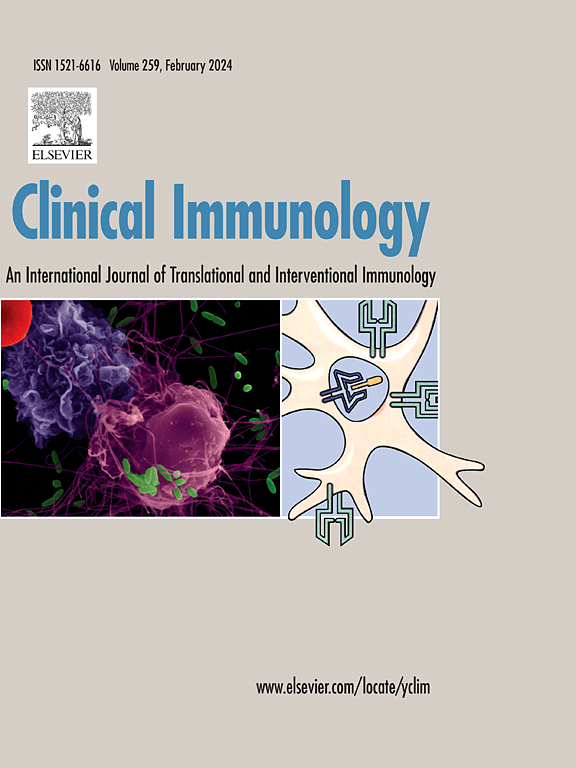Complement C5a and C5a receptor 1 mediates glomerular damage in focal segmental glomerulosclerosis
IF 3.8
3区 医学
Q2 IMMUNOLOGY
引用次数: 0
Abstract
Background
Clinical data and animal models have provided compelling evidence supporting the pathogenic role of complement activation in the progression of focal segmental glomerulosclerosis (FSGS). However, the mechanisms underlying complement-induced podocyte injury and parietal epithelial cell (PEC) activation are not well understood.
Methods
We evaluated glomerular C5aR1 (CD88) expression in FSGS patients and tested the effects of the C5aR1 antagonist (PMX205) in Adriamycin nephropathy mice. The effects on PECs and podocytes were evaluated following exposure to recombinant C5a or FSGS plasma, with or without the C5aR1 antagonist.
Results
C5aR1 was overexpressed on PECs and podocytes in FSGS patients, with levels positively correlated with serum creatinine, the percentage of segmental glomerulosclerosis, and the prognosis of refractory nephrotic syndrome. In Adriamycin nephropathy mice, the C5aR1 antagonist significantly attenuated proteinuria, blood urea nitrogen levels, and the percentage of segmental and global glomerulosclerosis. It also alleviated PEC activation and proliferation, and mitigated podocyte loss. Moreover, glomerular IgM deposits were reduced, followed by decreased deposits of C3d and C5b-9. In vitro, PECs exposed to recombinant C5a exhibited upregulated expression of CD44 and Notch1, along with increased secretion of COL4A2. Podocytes exposed to FSGS plasma showed impaired cell viability and downregulation of synaptopodin, effects that were reversed by the C5aR1 antagonist.
Conclusions
These findings highlight the pathogenic role of the complement system in the development of FSGS through the C5a-C5aR1 axis on podocytes and PECs. The C5aR1 antagonist represents a promising therapeutic intervention for FSGS patients.

补体C5a和C5a受体1介导局灶节段性肾小球硬化的肾小球损伤
临床数据和动物模型提供了令人信服的证据,支持补体激活在局灶节段性肾小球硬化(FSGS)进展中的致病作用。然而,补体诱导足细胞损伤和壁上皮细胞(PEC)激活的机制尚不清楚。方法检测FSGS患者肾小球C5aR1 (CD88)表达,并检测C5aR1拮抗剂(PMX205)对阿霉素肾病小鼠的影响。在有或没有C5aR1拮抗剂的情况下,评估暴露于重组C5a或FSGS血浆后对PECs和足细胞的影响。结果sc5ar1在FSGS患者PECs和足细胞上过表达,表达水平与血清肌酐、节段性肾小球硬化比例、难治性肾病综合征预后呈正相关。在阿霉素肾病小鼠中,C5aR1拮抗剂可显著降低蛋白尿、血尿素氮水平以及节段性和全局性肾小球硬化的百分比。它还能减轻PEC的活化和增殖,减轻足细胞的损失。此外,肾小球IgM沉积减少,随后C3d和C5b-9沉积减少。在体外,暴露于重组C5a的PECs表现出CD44和Notch1的上调表达,同时COL4A2的分泌增加。暴露于FSGS血浆的足细胞表现出细胞活力受损和突触肽下调,C5aR1拮抗剂可逆转这一效应。结论补体系统通过足细胞和PECs上的C5a-C5aR1轴在FSGS发生中的致病作用。C5aR1拮抗剂对FSGS患者是一种很有前景的治疗干预手段。
本文章由计算机程序翻译,如有差异,请以英文原文为准。
求助全文
约1分钟内获得全文
求助全文
来源期刊

Clinical immunology
医学-免疫学
CiteScore
12.30
自引率
1.20%
发文量
212
审稿时长
34 days
期刊介绍:
Clinical Immunology publishes original research delving into the molecular and cellular foundations of immunological diseases. Additionally, the journal includes reviews covering timely subjects in basic immunology, along with case reports and letters to the editor.
 求助内容:
求助内容: 应助结果提醒方式:
应助结果提醒方式:


